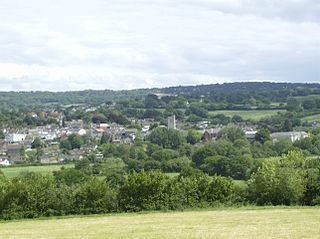
Axminster is a market town and civil parish on the eastern border of the county of Devon in England. It is 28 miles (45 km) from the county town of Exeter. The town is built on a hill overlooking the River Axe which heads towards the English Channel at Axmouth, and is in the East Devon local government district. At the 2001 census, it had a population of 5,626, increasing to 5,761 at the 2011 census. The town contains two electoral wards whose combined population is 7,110. The market is still held every Thursday.

A carpet is a textile floor covering typically consisting of an upper layer of pile attached to a backing. The pile was traditionally made from wool, but since the 20th century synthetic fibers such as polypropylene, nylon, or polyester have often been used, as these fibers are less expensive than wool. The pile usually consists of twisted tufts that are typically heat-treated to maintain their structure. The term carpet is often used in a similar context to the term rug, but rugs are typically considered to be smaller than a room and not attached to the floor.
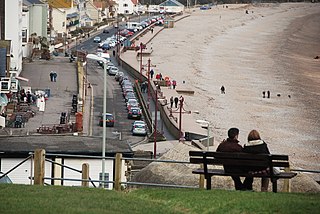
Seaton is a seaside town, fishing harbour and civil parish in East Devon on the south coast of England, between Axmouth and Beer. It faces onto Lyme Bay and is on the Dorset and East Devon Coast Jurassic Coast World Heritage Site. A sea wall provides access to the mostly shingle beach stretching for about a mile, and a small harbour, located mainly in the Axmouth area.

East Devon is a local government district in Devon, England. Its council is based in the town of Honiton, although Exmouth is the largest town. The district also contains the towns of Axminster, Budleigh Salterton, Cranbrook, Ottery St Mary, Seaton and Sidmouth, along with numerous villages and surrounding rural areas.

The Museum of English Rural Life, also known as The MERL, is a museum, library and archive dedicated to recording the changing face of farming and the countryside in England. The museum is run by the University of Reading, and is situated in Redlands Road to the rear of the institution's London Road Campus near to the centre of Reading in southern England. The location was formerly known as East Thorpe House and then St Andrew's Hall. It is an accredited museum and accredited archive as recognised by Arts Council England and the National Archives.

Axminster railway station serves the town of Axminster in Devon, England. It is operated by South Western Railway and is situated on the West of England Main Line. It is 144 miles 41 chains (232.6 km) down the line from London Waterloo.
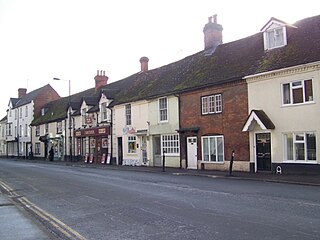
Wilton is a town and civil parish in Wiltshire, England. Lying about 3 miles (5 km) west of the city of Salisbury, and until 1889 the county town of Wiltshire, it has a rich heritage dating back to the Anglo-Saxons.
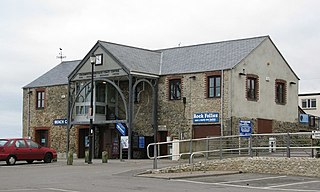
The Charmouth Heritage Coast Centre is based in the upstairs floor of a long-disused cement factory on the foreshore of Charmouth in Dorset, England.
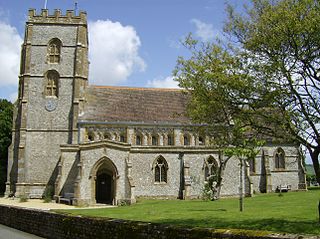
Hawkchurch is a village and civil parish in Devon, England, 3 miles (5 km) north east of Axminster on the border of Devon and Dorset, and about 6 miles (10 km) south of Somerset. It is 4 miles (6 km) north of the tourist and fishing town of Lyme Regis.

Colyton is a town in Devon, England. It is located within the East Devon local authority area, the river River Coly runs through it. It is 3 miles (5 km) from Seaton and 6 miles (10 km) from Axminster. Its population in 1991 was 2,783, reducing to 2,105 at the 2011 Census. Colyton is a major part of the Coly Valley electoral ward. The ward population at the above census was 4,493.
Thomas Whitty (1713–1792) was an English carpet manufacturer who founded Axminster Carpets in 1755.

Weston Museum is a museum in Weston-super-Mare, North Somerset, England. It was established in 1861. and is home to North Somerset Council museum collection with exhibits relating to Weston-super-Mare and the surrounding area from 400 million years ago to the present day.
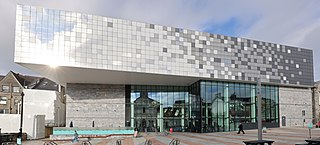
The Box is a museum, gallery and archive in Plymouth, Devon, England, opened in 2020 housing a collection of about 2 million items. The core of the building was previously Plymouth City Museum and Art Gallery which closed in 2016. The building was created in 1907–1910 by Thornely and Rooke in Edwardian Baroque style. and was combined with the former Central Library building and St Luke's Church on Tavistock Place into The Box.
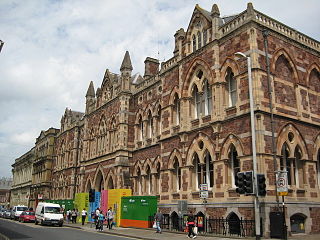
Royal Albert Memorial Museum & Art Gallery (RAMM) is a museum and art gallery in Exeter, Devon, the largest in the city. It holds significant and diverse collections in areas such as zoology, anthropology, fine art, local and overseas archaeology, and geology. Altogether the museum holds over one million objects, of which a small percentage is on permanent public display. It is a National Portfolio Organisation under the Arts Council England administered programme of strategic investment, which means RAMM receives funding (2012–15) to develop its services.
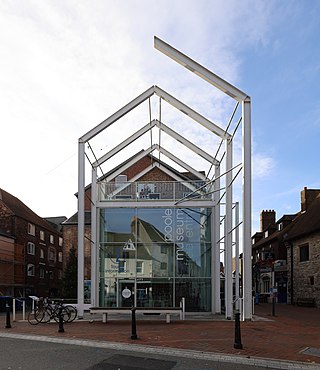
Poole Museum is a currently closed local history museum situated on the Lower High Street in the Old Town area of Poole, Dorset, and is part of the Borough of Poole Museum Service. Entrance to Poole Museum is free, and the museum is the fifth most visited free attraction in South West England.
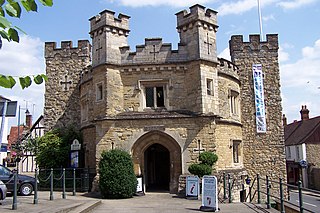
Buckingham Old Gaol, sometimes known as Lord Cobham’s Castle, is a historic building in Buckingham, the former county town of Buckinghamshire, England.

The Museum of Wigan Life is a public museum and local history resource centre in Wigan, Greater Manchester, England. The nineteenth-century listed building is by the noted architect Alfred Waterhouse. It originally housed Wigan Library, where George Orwell researched his book The Road to Wigan Pier in 1936.

The Tiverton Museum of Mid Devon Life is a local history museum in Tiverton, Devon, England, to the southwest of Gotham House. It features various exhibits relating to the social and economic history of the Mid Devon region, one of the most popular being a steam locomotive known as the "Tivvy Bumper". Founded in 1960 and initially located in rooms in a local pub, the museum is now housed in a Grade II listed former National School.
Axminster Carpets Ltd is an Axminster, Devon based English manufacturer of carpets, particularly the same-named Axminster carpets.

Buckfast is a small village near Buckfastleigh in Teignbridge district, Devon, England, on the bank of the River Dart. It is the home of Buckfast Abbey, an active Benedictine monastery, which gave its name to Buckfast Tonic Wine, originally made there, and to the Buckfast bee, a bee breed originally developed at Buckfast Abbey.


















